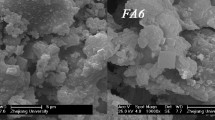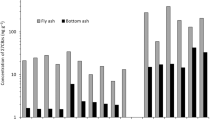Abstract
Chlorobenzenes (CBzs) are unintentionally produced organic contaminants from different thermal industrial processes, which have been scarcely surveyed in Asian developing countries including Vietnam. In this study, residue concentrations, profiles, emission factors, and annual emissions of seven chlorobenzene compounds were investigated in fly ash and bottom ash samples of some industrial facilities including brick making plant, steel and zinc production plants, and industrial and municipal waste incinerators in northern Vietnam. Total concentrations of seven CBzs in the ash samples were generally decreased in the order: industrial waste incinerator > municipal waste incinerator > steel-making plant > brick making plant. Emission pattern of CBzs varied considerably among different industrial plants, with 1,2- and 1,3-dichloro-, 1,2,3,4-tetrachloro-, and hexachlorobenzene as predominant compounds in the industrial waste incinerators and steel-making plants. Emission factors of CBzs estimated for the fly ash and bottom ash samples were in the range of 118–2020 and 5.3–22,600 μg ton−1, respectively. Average annual emissions (AEs) of total seven CBzs estimated for fly ash and bottom ash in the investigated plants were in the range of 154–54,300 and 20,160–161,400 mg year−1, respectively. The AEs of CBzs estimated for fly ash in the steel-making plant were higher than those in the waste incinerators. Meanwhile, CBz emissions for bottom ash were the highest in the steel-making plant, followed by the industrial and municipal waste incinerators. This is among the first studies on the emission characteristics of both low and highly chlorinated benzenes from industrial activities in Vietnam.




Similar content being viewed by others
References
Akimoto Y, Nito S, lnouye Y (1997) Comparative study on formation of polychlorinated dibenzo-p-dioxins, polychlorinated dibenzofurans and related compounds in a fluidized bed solid waste incinerator using long term used sand and fresh sand. Chemosphere 34:791–799
Antunes P, Viana P, Vinhas T, Rivera J, Gaspar EMSM (2012) Emission profiles of polychlorinated dibenzodioxins, polychlorinated dibenzofurans (PCDD/Fs), dioxin-like PCBs and hexachlorobenzene (HCB) from secondary metallurgy industries in Portugal. Chemosphere 88:1332–1339
Bailey RE, van Wijk D, Thomas PC (2009) Sources and prevalence of pentachlorobenzene in the environment. Chemosphere 75:555–564
Chen J, Wey M, Wu H (2007) Emission characteristics of chlorobenzenes, chlorophenols and dioxins during waste incineration with different additives. Combust Sci Technol 179:1039–1058
Fujimori T, Takaoka M, Tsuruga S, Oshita K, Takeda N (2010) Real-time gas-phase analysis of mono- to tri-chlorobenzenes generated from heated MSWI fly ashes containing various metal compounds: application of VUV-SPI-IT-TOFMS. Environ Sci Technol 44:5528–5533
Fujimori T, Tanino Y, Takaoka M (2014) Coexistence of Cu, Fe, Pb, and Zn oxides and chlorides as a determinant of chlorinated aromatics generation in municipal solid waste incinerator fly ash. Environ Sci Technol 48:85–92
Health Canada (2007) Federal contaminated site risk assessment in Canada, part II: Health Canada toxicological reference values (TRVs) and chemical-specific factors. http://publications.gc.ca/site/eng/387683/publication.html (Assessed 20 Jan 2018)
Hue NT, Nam H, Tung NH (2015) A preliminary investigation of pentachlorobenzene amount created from municipal waste incinerators and industrial furnaces at some provinces in northern Vietnam. Asian J Chem 27:1167–1170
Hue NT, Thuy NTT, Tung NH (2016) Polychlorobenzenes and polychlorinated biphenyls in ash and soil from several industrial areas in North Vietnam: residue concentrations, profiles and risk assessment. Environ Geochem Health 38:399–411
Jay K, Stieglitz L (1995) Identification and quantification of volatile organic components in emissions of waste incineration plants. Chemosphere 30:1249–1260
Li Y, Yang Y, Yu G, Huang J, Wang B, Deng S, Wang Y (2016) Emission of unintentionally produced persistent organic pollutants (UPOPs) from municipal waste incinerators in China. Chemosphere 158:17–23
Liu G, Zheng M, Liu W, Wang C, Zhang B, Gao L, Su G, Xiao K, Lv P (2009) Atmospheric emission of PCDD/fs, PCBs, hexachlorobenzene, and pentachlorobenzene from the coking industry. Environ Sci Technol 43:9196–9201
Liu G, Liu W, Cai Z, Zheng M (2013) Concentrations, profiles, and emission factors of unintentionally produced persistent organic pollutants in fly ash from coking processes. J Hazard Mater 261:421–426
Liu X, Fiedler H, Gong W, Wang B, Yu G (2018) Potential sources of unintentionally produced PCB, HCB and PeCBz in China: a preliminary overview. Front Environ Sci Eng 12(1). https://doi.org/10.1007/s11783-018-1036-9
Lysychenko G, Weber R, Gertsiuk M, Kovach V, Krasnova I (2015) Threats to water resources from hexachlorobenzene waste at Kalush City (Ukraine)—a review of the risks and the remediation options. Environ Sci Pollut Res Int 22:14391–14404
Malcolm HM, Howe PD, Dobson S (2004) Chlorobenzenes other than hexachlorobenzene: environmental aspects. World Health Organization. http://www.who.int/ipcs/publications/cicad/en/cicad60.pdf (Assessed 10 June 2018)
Mumma CE, Lawless EW (1975) Survey of industrial processing data: task i—hexachlorobenzene and hexachlorobutadiene pollution from chlorocarbon processing. Midwest Research Institute prepared for US Environmental Protection Agency. June 1975. Available online at National Service Center for Environmental Publications (NSCEP)
Murakami T, Shimura M, Kasai E (2008) Formation of hexachlorobenzene from dusts of an electric arc furnace used in steelmaking: effect of temperature and dust composition. Environ Sci Technol 42:7459–7463
Nie Z, Zheng M, Liu W, Zhang B, Liu G, Su G, Lv P, Xiao K (2011) Estimation and characterization of PCDD/Fs, dl-PCBs, PCNs, HxCBz and PeCBz emissions from magnesium metallurgy facilities in China. Chemosphere 85:1707–1712
Nie Z, Liu G, Liu W, Zhang B, Zheng M (2012) Characterization and quantification of unintentional POP emissions from primary and secondary copper metallurgical processes in China. Atmos Environ 57:109–115
Nouwen J, Cornelis C, De Fre R, Wevers M, Viaene P, Mensink C et al (2001) Health risk assessment of dioxin emissions from municipal waste incinerators: the Neerlandquarter (Wilrijk, Belgium). Chemosphere 43:909–923
Petrlik J, Bell L (2017) Toxic ash poisons our food chain. IPEN report, April 2017. www.ipen.org/sites/default/files/documents/ipen-toxic-fly-ash-in-food-v1_4a-en-web.pdf (Accessed 10 Oct 2018)
POPs Review Committee (2010) Additional consideration of new persistent organic pollutants: pentachlorobenzene. Persistent Organic Pollutants Review Committee Sixth meeting, Geneva 11–15 October 2010 (UNEP/POPS/POPRC.6/INF/21). chm.pops.int/Portals/0/download.aspx?d=UNEP-POPS-POPRC.6-INF-21.English.pdf (Accessed 10 Oct 2018)
Ren Z, Lu Y, Li Q, Sun Y, Wu C, Ding Q (2018) Occurrence and characteristics of PCDD/Fs formed from chlorobenzenes production in China. Chemosphere 205:267–274
Taylor PH, Lenoir D (2001) Chloroaromatic formation in incineration processes. Sci Total Environ 269:1–3):1–24
Tian B, Huang J, Wang B, Deng S, Yu G (2012) Emission characterization of unintentionally produced persistent organic pollutants from iron ore sintering process in China. Chemosphere 89:409–415
US EPA (1994a) Method 8121: Chlorinated Hydrocarbons by Gas Chromatography–Capillary column technique
US EPA (1994b) Locating and estimating air emissions from sources of chlorobenzenes (Revised). https://www3.epa.gov/ttn/chief/le/chlorbnz.pdf (Accessed 11 July 2018)
US EPA (2006) Toxicological review of dichlorobenzenes. https://ofmpub.epa.gov/eims/eimscomm. getfile?p_download_id=457549 (Accessed 17 Oct 2018)
Weber R, Watson A, Malkov M, Costner P, Vijgen J (2011) Unintentionally produced hexachlorobenzene and pentachlorobenzene POPs waste from solvent productions—the need to establish emission factors and inventories. Organohalogen Compd 73:2205–2208
Yan M, Li X, Chen T, Lu S, Yan J, Cen K (2010) Effect of temperature and oxygen on the formation of chlorobenzene as the indicator of PCDD/Fs. J Environ Sci 22:1637–1642
Zhang T, Fiedler H, Yu G, Ochoa GS, Carroll WF Jr, Gullett BK, Marklund S, Touati A (2011) Emissions of unintentional persistent organic pollutants from open burning of municipal solid waste from developing countries. Chemosphere 84:994–1001
Zimmermann R, Heger HJ, Blumenstock M, Dorfner R, Schramm KW, Boesl U, Kettrup A (1999) On-line measurement of chlorobenzene in waste incineration flue gas as a surrogate for the emission of polychlorinated dibenzo-p-dioxins/furans (I-TEQ) using mobile resonance laser ionization time-of-flight mass spectrometry. Rapid Commun Mass Spectrom 13:307–314
Funding
Financial support was provided by the National Foundation for Science and Technology Development (NAFOSTED) of Vietnam with the Project “Evaluate emission capacity, assessment of risk and the transformation between pentachlorobenzene and hexachlorobenzene in the environment from incineration of industrial activities” (Code: 104.04-2015.45).
Author information
Authors and Affiliations
Corresponding authors
Additional information
Responsible editor: Constantini Samara
Rights and permissions
About this article
Cite this article
Nguyen, H.T., Nguyen, T.T.T., Tung, N.H. et al. Levels, profiles, and emission characteristics of chlorobenzenes in ash samples from some industrial thermal facilities in northern Vietnam. Environ Sci Pollut Res 26, 188–198 (2019). https://doi.org/10.1007/s11356-018-3591-9
Received:
Accepted:
Published:
Issue Date:
DOI: https://doi.org/10.1007/s11356-018-3591-9




